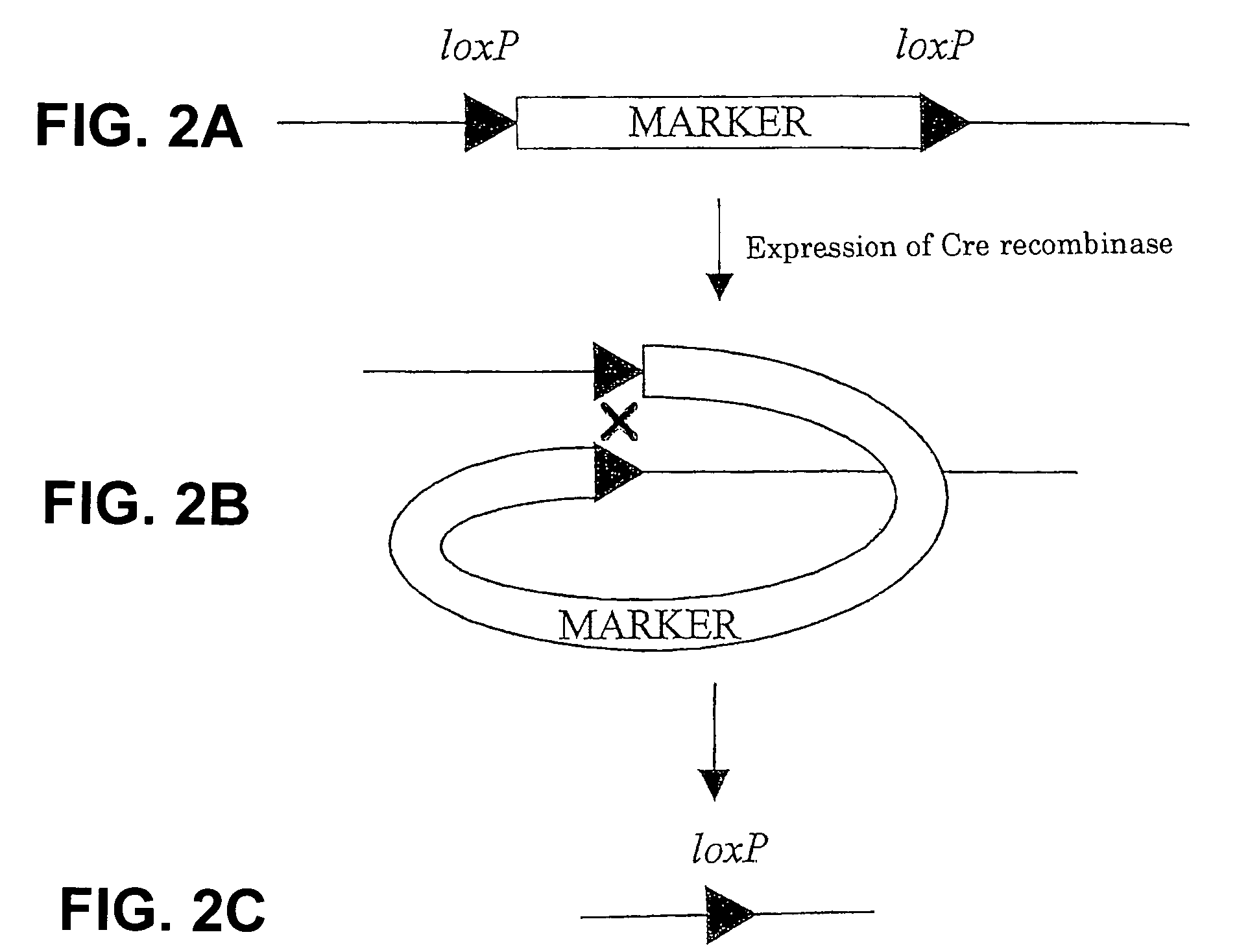Method for modifying chromosomes
a technology of chromosome and chromosome fragment, which is applied in the field of chromosome modifying method of yeast, can solve the problems of requiring a large number of complicated steps, and only applying techniques, and achieves the effect of preparing a chromosome splitting vector easily
- Summary
- Abstract
- Description
- Claims
- Application Information
AI Technical Summary
Benefits of technology
Problems solved by technology
Method used
Image
Examples
reference example 1
Construction of a Plasmid pSK+CgHIS3 as a Template for Construction of the Chromosome Splitting Vector (1)
[0065]A plasmid pSK+CgHIS3 is obtained by incorporating a CgHIS3 gene, which is incorporated into loxP sites of a Cre-loxP system, into pBluescript II SK+ (STRATAGENE).
[0066]First, PCR was performed, using primers CgHIS3-1 and CgHIS3-2 having the following sequences, and a plasmid p1417 having a CgHIS3 gene as a template.
[0067]
(Sequence ID No. 1)CgHIS3-1: 5′-CTCTCTAGATAACACCGATCAGATGCACA-3′(Sequence ID No. 2)CgHIS3-2: 5′-CTCCTCGAGAAACTTGCTCTGCTAACTCA-3′
[0068]The obtained DNA fragment of about 1.62 kbp was cloned into pT7Blue-T vector (Novagen) with T4DNA ligase to construct a plasmid pT7-CgHIS3. The primer CgHIS3-1 has a sequence that generates a restriction enzyme XbaI cleavage site. Similarly, the primer CgHIS3-2 has a sequence that generates a restriction enzyme XhoI cleavage site.
[0069]Then, the plasmid pT7-CgHIS3 was digested with a restriction enzyme XbaI / XhoI. A DNA fragm...
reference example 2
Construction of a Plasmid pSK+CEN4 as a Template for Constructing the Chromosome Splitting Vector (2)
[0071]A plasmid pSK+CEN4 is a plasmid having a centromere sequence of a yeast, and is used as a template for constructing the chromosome splitting vector (2). In this plasmid, a CEN4 gene is incorporated into pBluescript II SK+ (STRATAGENE) as centromere.
[0072]First, PCR was performed, using CEN4-1 and CEN4-2 having the following sequences as primers, and a chromosomal DNA of a wild-type budding yeast strain S288C as a template.
[0073]
(Sequence ID No. 3)CEN4-1: 5′-CTCGAATTCGGCCATTCTCATGAAGAATA-3′(Sequence ID No. 4)CEN4-2: 5′-CTCGAATTCTCTAAGAGGTGATACTTATT-3′
[0074]The obtained DNA fragment of about 0.85 kbp was cloned into pT7Blue-T vector (Novagen) with T4DNA ligase to construct a plasmid pT7-CEN4. Each primer CEN4-1 and CEN4-2 has a sequence that generates a restriction enzyme EcoRI cleavage site, respectively.
[0075]Then, the obtained pT7-CEN4 was digested with a restriction enzyme Ec...
example 1
Production of a Chromosome Splitting Vector
[0076]FIG. 5 is a schematic diagram showing production of chromosome splitting vectors (1A), (2A), (1B) and (2B).
[0077]Production of Chromosome Splitting Vector (1A)
[0078]The following primers were used:
[0079]
chIY-11: 5′-GAATGCTATGTTGTGGTTAGCGACCTGCCCCTTGCCAAATCTA(Sequence ID No. 5)TATCACCACTTCCTTAGCATGTAATCATTTACTTAAAGGAAACAGCTATGACCATG-3′,andTr6-1: 5′-CCCCAACCCCAACCCCAACCCCAACCCCAACCCCAATCGAGGT(Sequence ID No. 6)CGACGGTATCGAT-3′.
[0080]The primer chIY-11 (Sequence ID No.5) has 99bases. The 80 bases from the 5′ terminal of the chIY-11 constitute a region homologous to the nucleotide sequence of 119795 bp to 119874 bp of chromosome I, which is the target sequence. The remaining 19 bases constitute a region homologous to the plasmid pSK+CgHIS3. The primer Tr6-1 has the (C4A2)6 sequence and 20-base sequence homologous to sequences of the plasmid pSK+CgHIS3. PCR was performed using these two primers, and the plasmid pSK+CgHIS3 as a template, an...
PUM
| Property | Measurement | Unit |
|---|---|---|
| size | aaaaa | aaaaa |
| length | aaaaa | aaaaa |
| energy | aaaaa | aaaaa |
Abstract
Description
Claims
Application Information
 Login to View More
Login to View More - R&D
- Intellectual Property
- Life Sciences
- Materials
- Tech Scout
- Unparalleled Data Quality
- Higher Quality Content
- 60% Fewer Hallucinations
Browse by: Latest US Patents, China's latest patents, Technical Efficacy Thesaurus, Application Domain, Technology Topic, Popular Technical Reports.
© 2025 PatSnap. All rights reserved.Legal|Privacy policy|Modern Slavery Act Transparency Statement|Sitemap|About US| Contact US: help@patsnap.com



